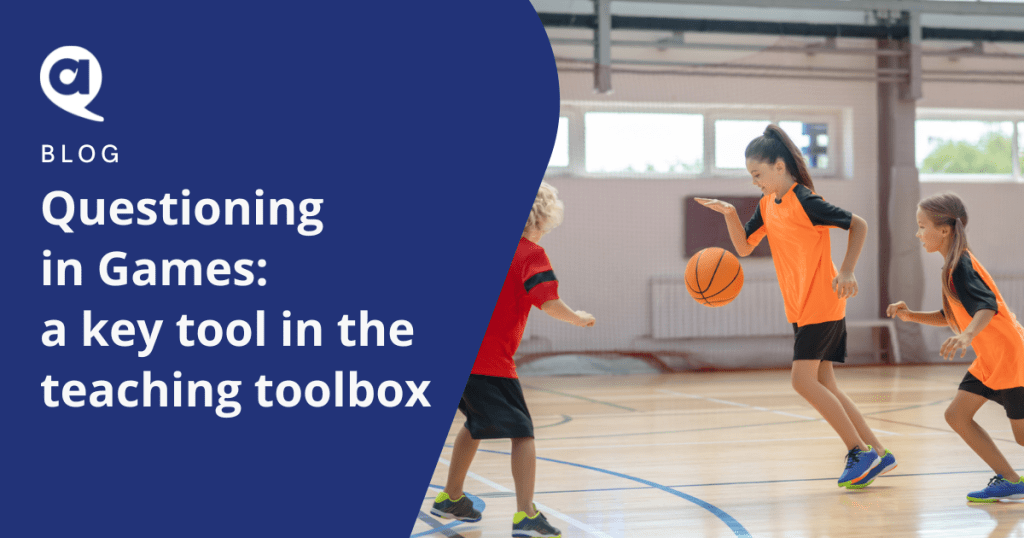
November 2022
by Dr Kelly Ann Parry
Lecturer, ACPE
ACHPER NSW Board member
Kelly will present a PDHPE Masterclass: Developing Thinking Students, 30 May 2023. Find out more
Effective questioning is a critical skill teachers can use to engage students in their learning and is a central pedagogical device in making learning visible (Pill, 2016).
Developing productive and generative questioning to promote deep thinking and dialogue when teaching games is a pedagogical tool teachers need to develop to facilitate learning (Harvey & Light, 2016). As facilitators, teachers will need to know when to use questions and when to provide answers. These questions cannot be answered simply with skinny, closed (yes or no) responses, but rather open (fat) questions and require children to think deeply about their answers and seek complex solutions (Harvey & Light, 2016).
Questioning skills and the ability to develop appropriate activities to allow the questions to be answered are central to the success of the Game-Based Approach (Light, 2003; Pearson &Webb, 2008). Questioning in games needs to focus learning on the tactical problem to be solved within the game, direct students to think about movement on and off the ball and shift the focus to decision-making and tactical awareness, e.g. How do you support the player with the ball when in an off-the-ball position? (Pill, 2016). For the teacher, questioning strategies are used to pose questions and gain insight and information from students about what they are processing or not processing (Griffin & Butler, 2005). It is important to challenge the students through questioning constantly.
Questioning strategies
Pearson and Webb (2008) suggest that questions can be organised into four types depending on the cognitive activity involved:
Recall questions
- Require memory level answer – brings attention to what has previously been learnt
Examples: Where should your eyes be when they are dribbling What do we already know about setting up attack from the net?
Convergent questions
- Aid analysis and integration of previously learned material require reasoning and problem solving – brings player to an answer which is unambiguous.
- Examples: Why should you stay between your opponent and the basket? Is the ball in if it hits the line?
Divergent questions
- Require solutions to new situations through problem solving – brings player attention to possibilities.
- Examples: What ways would you start a fast break off a steal? What options do we have bringing the ball forward?
Value questions
- Require expressions of choice, attitude and opinion – brings player attention to ethical and moral dimensions.
- Examples: How do you react? Is that how we want to play?
(Adapted from Pearson & Webb, 2008; Pill, 2016).
Questioning protocol
A questioning protocol such as the ‘What? Where? When? Why? with Whom? And How?’ framework (Griffin & Butler, 2005) can be used to formulate questions. Pearson and Webb (2008) suggest that in virtually every game, or practice, teachers need to look at the scenario and ask students the following questions:
- What is going wrong?
- Where does the problem occur?
- When does the problem occur?
- Why does the problem occur?
- Who owns the problem?
- How can it be fixed?
Mitchell, Oslin and Griffin (2006) reinforce that the quality of your questions is critical, and these questions should be an integral part of your planning. They propose that questions fall into three categories:
- Time: ‘When is the best time to?’
- Space: ‘Where is or where can?’
- Risk: ‘Which choice is safest, and which is most risky?’
Pill (2007) adapts these question prompts into a matrix using Time, Space, Force, and Movement concepts, with the addition of Risk (Choice) (Mitchell, Oslin, & Griffin, 2006).
Harvey and Light (2016) provide a range of frameworks and strategies to support teachers in effectively using productive and generative questioning. These strategies support teachers in moving beyond simplistic questioning to using questioning approaches for promoting deep thinking and dialogue.
These strategies include:
- The use of skinny or fat questions (Kagan, 2005) – Skinny questions: yes/no (closed questions) type of answer and little thinking on the part of the student. Fat questions: require more evaluation, synthesis, and evaluation on behalf of the learner (open questions).
- Question starters (Kracl, 2012) – a list of ‘question starters’ that would enable teachers to increase the range of student cognition and the inclusion of a wider range of learners.
- The ‘debate of ideas’ (Gréhaigne et al., 2005) – a framework or a pre-prepared list of generic questions for small teams of learners to lead their own ‘tactical timeouts’.
Reflective Toss (Zee & Minstrell, 1997) – dialogue that begins with a statement from a student on their perspective on the game play interaction.
(Harvey & Light, 2016, p. 182)
About the Author
Dr Kelly Ann Parry
ACHPER NSW Board and Lecturer, Australian College of Physical Education
 Kelly will present the Developing Thinking Players workshop at the upcoming ACHPER NSW PDHPE Conference. She is a passionate educator with a philosophy grounded in student-centric and innovative pedagogies. She has lead PDHPE faculties in Australia and the UK. Kelly believes in supporting students to be physically literate and providing authentic learning experiences so that students can value movement. Her research focuses on games-based pedagogy and how to support teachers to teach through games.
Kelly will present the Developing Thinking Players workshop at the upcoming ACHPER NSW PDHPE Conference. She is a passionate educator with a philosophy grounded in student-centric and innovative pedagogies. She has lead PDHPE faculties in Australia and the UK. Kelly believes in supporting students to be physically literate and providing authentic learning experiences so that students can value movement. Her research focuses on games-based pedagogy and how to support teachers to teach through games.
References
Gréhaigne, J.-F., Richard, J.-F., & Griffin, L. L. (2005). Teaching and learning team sports and games. New York, NY: Routledge. Falmer.
Griffin, L., and Butler, J.(2005) Teaching Games for Understanding. Theory, Research and Practice. Illinois. Human Kinetics.
Harvey, S. and Light, R. (2015) Questioning for learning in game-based approaches to teaching and coaching, Asia-Pacific Journal of Health, Sport and Physical Education, 6:2, 175-190, DOI: 10.1080/18377122.2015.1051268
Kagan, S. (2005). Rethinking thinking. Does Bloom’s taxonomy align with brain science? Kagan Online Magazine, 8(3). www.KaganOnline.com
Kracl, C. L. (2012). Review or true? Using higher-level thinking questions in social studies instruction. The Social Studies, 103, 57–60. doi:10.1080/00377996.2011.586382
Light, R. (2013). Game sense: pedagogy for performance, participation, and enjoyment. London: Routledge.
Mitchell, S., Oslin, J. L and Griffin, L. (2006) Teaching Sport Concepts and Skills. A Tactical Games Approach. Illinois: Human Kinetics.
Pearson, P., & Webb, P. (2008). Developing effective questioning in Teaching Games for Understanding (TGfU). 1st Asia Pacific Sport in Education Conference: Play to Educate, Flinders University, Adelaide,
Pill, S. (2007). Play with Purpose. Hindmarsh, SA: Australian Council for Health, Physical Education, Recreation and Dance.
Pill, S. (2014). The Pedagogy of Questioning in a Game Sense Approach. 2015 Game Sense for Teachers and Coaches Conference Proceedings. Pp.143-155. Christchurch November 19-20, 2015. https://www.achper.org.au/documents/item/433
Pill, S. (2016). Making Learning Visible – The Pedagogy of Questioning in a Game Sense Approach. In J. Bruce & C. North (Eds.) 2015 Game Sense for Teachers and Coaches Conference: Proceedings (pp. 143-155), Christchurch, November 19-20, 2015. http://www.education.canterbury.ac.nz/sportpe/gamesense/documents/game-sense-for-teachers-and-coaches-conference-proceedings.pdf


